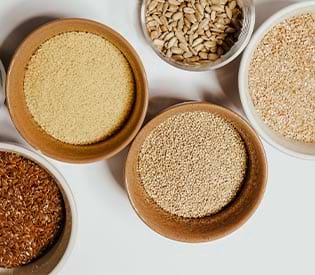Blue Cohosh Root
📦🚚 Fast & Free shipping on all orders
What is blue cohosh root?
Blue cohosh is a flowering herb that is native to North America. It thrives in rich, moist soil and may be found growing in wooded regions along the east coast of both the United States and Canada. It features roots that are yellowish in color, little flowers that are yellowish green, and berries that are blue . The phrase "squaw root" was once extensively used to describe blue cohosh because of its history of being used by Native American women as a labor aid; however, due to the pejorative connotations associated with the term, it is no longer commonly used. Be careful not to mix blue cohosh with black cohosh, which is an entirely different herbal medicine that is also used for women's health concerns but is regarded as being far safer than blue cohosh.
How do I use blue cohosh root?
The recommended dosage of blue cohosh tincture is 1–2 ml, to be consumed no more than three times daily. Occasionally, the entire herb (300–1,000 milligrams per day) is utilized. Commonly, blue cohosh is utilized in conjunction with other botanicals.
Blue cohosh root benefits:
Although blue cohosh was used to treat various illnesses, such as uterine inflammation, arthritis, and heart failure, its principal usage was for labor induction during childbirth. Other uses for blue cohosh included these treatments. Up until the year 1890, the United States Pharmacopeia approved the use of blue cohosh as a medication, making it a common practice among doctors and midwives in the 19th century. Although it has been used in traditional medicine for a very long time, there is no contemporary data to show that blue cohosh is either safe or effective when taken during pregnancy.
◉ Aids and induces labor: At one time, blue cohosh was thought to be among the most effective herbs for inducing labor in preparation for a natural childbirth. While it does contain components that induce uterine contractions, it also has a calming effect, which can help reduce some of the discomfort associated with pregnancy. Blue cohosh, in various prepared forms, was frequently employed for this purpose by Native Americans and, not long after, by European settlers. The herb known as blue cohosh has traditionally been used as a general uterine tonic because of its ability to promote blood flow to the pelvic region. Even though it shouldn't be taken when a woman is pregnant, midwives in current times still utilize it to assist mothers who desire to give birth without any medical interventions.
It is important to note that blue cohosh shouldn't be consumed at any point during pregnancy unless the goal is to hasten the onset of labor, and only then under the supervision of a qualified medical expert. If taken close to the time of delivery, it may result in a spontaneous abortion or miscarriage.
◉ Relieves Pain and Cramping: Blue cohosh may continue to be beneficial to women after they have given birth. Because of its anti-inflammatory and anti-spasmodic characteristics, it can help ease the pain and cramping that might occur in the uterus after giving birth. Blue cohosh has been used for centuries to aid in a speedier recovery after childbirth, and it also works to lessen the intensity of the uterine contractions that occur after delivery.
When creating a postpartum herbal remedy, blue cohosh is typically mixed with several additional plants known for their curative properties. It works well in conjunction with herbs such as red raspberry leaf, which gives your body the food it needs, and cramp bark, which, as its name suggests, also helps relieve cramping in the muscles. You can get some postpartum relief with the help of blue cohosh by drinking this holistic Afterbirth Ease tea.
◉ Helps with Painful or Absent Periods: Blue cohosh has a long history of use as a remedy for various menstrual issues, including cramping, absent or delayed bleeding, and delayed or delayed bleeding altogether. An emmenagogue is a type of herb that is known to boost blood flow to the pelvic region and bring on menstruation. Blue cohosh root is one of the herbs that falls into this category. Its antispasmodic characteristics aid in reducing cramping as well as the painful periods that are associated with them. When coupled with other herbs, such as black cohosh, blue cohosh has the potential to produce a more potent treatment for menstrual issues such as cramping and delayed periods.
◉ Blue cohosh heart failure: Blue cohosh has the potential to reduce the size of blood vessels in the heart, which would result in a lower amount of oxygen reaching the heart. Furthermore, It is possible that it will induce an increase in blood pressure and a racing heartbeat. If you have a cardiac issue, you should avoid using blue cohosh.
Where can I buy blue cohosh root?
Buy blue cohosh root from the health food store in the USA, Alive Herbals.
Blue Cohosh Root Information (at a Glance):
| Product Name | Blue Cohosh Root. |
| Scientific Name | Caulophyllum thalictroides. |
| Country of Origin |
It is native to eastern North America. |
| Ingredient |
Blue Cohosh Root. |
| Taste and Aroma |
Aroma: not smelling of anything. Bitter and sweet, with a sour aftertaste. |
| Shelf Life and Storage |
Shelf life is about 6–36 months. Store it in an airtight container in a cool, dry place and prevent sunlight exposure. |
| Precautions |
We requested you, before consuming spices, herbs, teas or any kind of natural products, to consult an expert qualified healthcare practitioner or herbalist. |
| Note | This product information has not been appraised by the Food and Drug Administration (FDA). This information is solely intended for educational purposes. |







